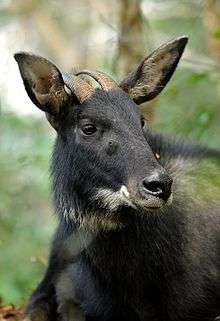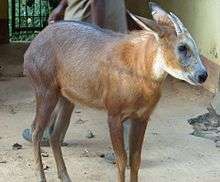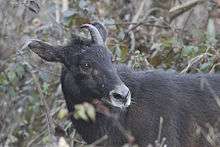Serow
The serows (/səˈroʊ/ or /ˈsɛroʊ/) are six species of medium-sized goat-like or antelope-like mammals of the genus Capricornis.
| Serow[1] | |
|---|---|
| Sumatran Serow (Capricornis sumatraensis) at Dusit Zoo, Bangkok, Thailand. | |
| Scientific classification | |
| Kingdom: | Animalia |
| Phylum: | Chordata |
| Class: | Mammalia |
| Order: | Artiodactyla |
| Family: | Bovidae |
| Subfamily: | Caprinae |
| Genus: | Capricornis Ogilby, 1836 |
| Species | |
|
Capricornis crispus | |
Extant species
All six species of serow were until recently also classified under Naemorhedus, which now only contains the gorals. They live in central and eastern Asia.
| Image | Scientific name | Common Name | Distribution |
|---|---|---|---|
| Capricornis crispus | Japanese serow | four main islands of Japan | |
| Capricornis sumatraensis | Sumatran serow | Thai-Malay Peninsula and on the Indonesian island of Sumatra | |
 | Capricornis milneedwardsii | Chinese serow | China and Southeast Asia |
 | Capricornis rubidus | Red serow | southern Bangladesh and northern Burma |
 | Capricornis thar | Himalayan serow | eastern Himalayas and eastern and southeastern Bangladesh |
 | Capricornis swinhoei | Taiwan serow | Taiwan |
Like their smaller relatives the gorals, serows are often found grazing on rocky hills, though typically at a lower elevation when the two types of animal share territory. Serows are slower and less agile than gorals, but they nevertheless can climb slopes to escape predation, and to take shelter during cold winters or hot summers. Serows, unlike gorals, make use of their preorbital glands in scent marking.
Coloration varies by species, region, and individual. Both sexes have beards and small horns which are often shorter than their ears.
Fossils of serow-like animals date as far back as the late Pliocene, two to seven million years ago. The common ancestor species of the Caprinae subfamily may have been very similar to modern serows.
The serow subfamily population as a whole is considered endangered. Most serow species are included in the red list of IUCN with decreasing populations. The Japanese serow is better protected than the other sub-species of serows (source: IUCN 2008).
References
- Grubb, P. (2005). Wilson, D.E.; Reeder, D.M. (eds.). Mammal Species of the World: A Taxonomic and Geographic Reference (3rd ed.). Johns Hopkins University Press. pp. 703–705. ISBN 978-0-8018-8221-0. OCLC 62265494.
External links
- . Encyclopædia Britannica. 24 (11th ed.). 1911.